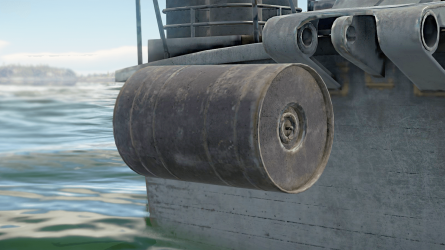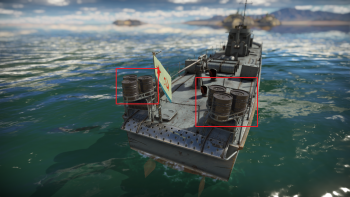Difference between revisions of "BB-1 depth charge"
Colok76286 (talk | contribs) (Edits) |
(→History: Added History) (Tag: Visual edit) |
||
| Line 53: | Line 53: | ||
'''Pros:''' | '''Pros:''' | ||
| + | |||
* Very powerful weapon when used strategically | * Very powerful weapon when used strategically | ||
* Can have a time delay from 3 to 10 seconds, allowing for a variety of uses (short-term grenade placed in-front of opponents or more long-term strategic 'mine' placement) | * Can have a time delay from 3 to 10 seconds, allowing for a variety of uses (short-term grenade placed in-front of opponents or more long-term strategic 'mine' placement) | ||
'''Cons:''' | '''Cons:''' | ||
| + | |||
* Difficult to use effectively, due to its 'static' nature | * Difficult to use effectively, due to its 'static' nature | ||
== History == | == History == | ||
| − | + | In World War I Russian ASW weapons and technology were primitive and ineffective with no enemy submarines being sunk by the Russian Navy with depth charges. There were no sonars or any acoustic detection devices in the navy and no effective ASW doctrine. | |
| + | |||
| + | No Soviet ship had sonar until 1941 and most of them did not receive any until the middle of the war. However, only 5% of the ships lost by the Soviet Navy were from submarine attacks and hence ASW efforts were not as important to the Soviet Navy as to other nations. | ||
| + | |||
| + | The BB-1 was the main heavy depth charge of the Soviet Navy in World War II and the Cold War, and could be deployed from a B-1 lever rack or launched from BMB-1 depth charge projectors, which were installed on most soviet destroyers during the war. In the Cold War, the Soviets developed the BMB-2 depth charge projector, which could throw a BB-1 further and more effectively.<ref>http://www.navweaps.com/Weapons/WAMRussian_ASW.php</ref> | ||
== Media == | == Media == | ||
| Line 74: | Line 80: | ||
== External links == | == External links == | ||
''Paste links to sources and external resources, such as:'' | ''Paste links to sources and external resources, such as:'' | ||
| + | |||
* ''topic on the official game forum;'' | * ''topic on the official game forum;'' | ||
* ''other literature.'' | * ''other literature.'' | ||
Revision as of 02:41, 11 May 2023
Contents
Description
The BB-1 depth charge (Russian: Бомба Большая (Глубинная), "Large bomb (depth)") is a Soviet naval depth charge. It is a larger version of the BM-1 (Russian: Бомба Малая (Глубинная), Small bomb (depth)).
Depth charge mechanics in War Thunder are very basic, being simple, medium-sized bombs deployed from naval vessels. Their area of effect is almost precisely vertically upwards, somewhat alike torpedoes, except depth charges, do not move from their deployed location except to sink.
Vehicles equipped with this weapon
| Vehicles equipped with this weapon | |
|---|---|
| Motor gun boats | MO-4 · OD-200 |
| Motor torpedo boats | D-3 · Pr.123K · Pr.123K (A-10bis) · Pr.183 |
| Motor torpedo gun boats | MPK Pr.12412 · MPK Pr.12412P · Pr. 206 · ▀Pr. 206 |
| Armoured gun boats | BMO |
| Gunboats | Groza |
| Sub-chasers | MPK Pr.122bis · MPK pr.122A · MPK-163 |
| Frigates | Karl Marx · Yenot · MPK Pr.1331M |
| Destroyers | Soobrazitelny · Stroyny · Ognevoy · Bezuprechny · Smelyi · Spokoinyy |
General info
Tell us about the tactical and technical characteristics of the depth charge.
Effective damage
The depth charges produce focused splash damage right above their location, like a vertical torpedo. Although originally they were designed to produce both explosive and shockwave damage underwater to destroy submarines, in War Thunder, there are no submarine vehicles and as a result, the depth charges have a very focused area of effect.
Comparison with analogues
The depth charges are comparable to static torpedoes which explode after a time delay. Numbers-wise, the BB-1 depth charges are comparable to a 150 kg bomb.
Usage in battles
Depth charges require much more skill to serve any purpose in comparison to torpedoes, due to the fact you either have to be very close to the opponent or you have to predict the path the opponents may take.
An important aspect of using depth charges is to set its activation time (depth charges do not have proximity fuses). You can set the activation time before battle, whenever you have depth charges installed. It is recommended to use some time in the middle (5-8s) to allow some variety, but if you know that you are going to face faster boats (earlier tiers) or slower, larger boats (later tiers), then you can use a faster activation time (3-5s) or a slower activation time (7-10s) respectively.
There two main strategies for using depth charges in battle: 1) cutting in-front of enemies and planting depth charges, usually in a motorboat; 2) planting depth charges around the perimeter of a strategic point before enemies pass through. The former strategy can be adapted to suit close-quarter battles when the opponent is right up against your side where you can plant the depth charge and hope that the splash damage hull-break the opponent; the latter strategy requires an above-average game sense and knowledge of the map.
Pros and cons
Pros:
- Very powerful weapon when used strategically
- Can have a time delay from 3 to 10 seconds, allowing for a variety of uses (short-term grenade placed in-front of opponents or more long-term strategic 'mine' placement)
Cons:
- Difficult to use effectively, due to its 'static' nature
History
In World War I Russian ASW weapons and technology were primitive and ineffective with no enemy submarines being sunk by the Russian Navy with depth charges. There were no sonars or any acoustic detection devices in the navy and no effective ASW doctrine.
No Soviet ship had sonar until 1941 and most of them did not receive any until the middle of the war. However, only 5% of the ships lost by the Soviet Navy were from submarine attacks and hence ASW efforts were not as important to the Soviet Navy as to other nations.
The BB-1 was the main heavy depth charge of the Soviet Navy in World War II and the Cold War, and could be deployed from a B-1 lever rack or launched from BMB-1 depth charge projectors, which were installed on most soviet destroyers during the war. In the Cold War, the Soviets developed the BMB-2 depth charge projector, which could throw a BB-1 further and more effectively.[1]
Media
Excellent additions to the article would be video guides, screenshots from the game, and photos.
See also
External links
Paste links to sources and external resources, such as:
- topic on the official game forum;
- other literature.
| Naval depth charges | |
|---|---|
| USA | Mk.6 · Mk.6 mortar · K-gun Mk.9 |
| Germany | WBD · WBF · WBG |
| Foreign: | BB-1 (USSR) · Mk.6 (USA) · Type 95 (Japan) |
| USSR | BB-1 · BM-1 · MBU-600 mortar · RBM mortar |
| Britain | Limbo mortar · Mk.10 Hedgehog mortar · Mk.VII · Y-gun Mk.VII |
| Foreign: | Mk.6 mortar (USA) |
| Japan | Type 3 · Type 95 |
| Foreign: | Mk.6 mortar (USA) · Mk.9 (USA) · Mk.10 Hedgehog (Britain) |
| Italy | B TG · B TG 100 · BAS · Mk.4 |
| Foreign: | WBG (Germany) · Mk.10 Hedgehog (Britain) |
| France | Guiraud |
| Foreign: | Mk.VII (Britain) · Y-gun Mk.VII (Britain) |





